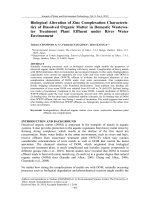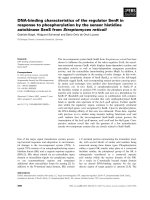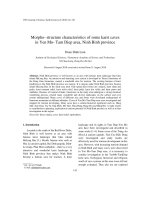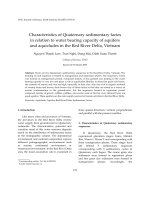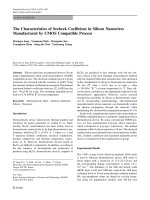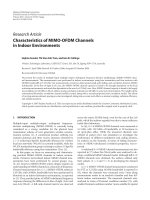DISTINCTIVE CHARACTERISTICS OF INSULIN GLUCOSE METABOLISM IN INTRAUTERINE GROWTH RESTRICTED AND IMPAIRED GLUCOSE TOLERANCE NONHUMAN PRIMATES
Bạn đang xem bản rút gọn của tài liệu. Xem và tải ngay bản đầy đủ của tài liệu tại đây (2.05 MB, 94 trang )
DISTINCTIVE CHARACTERISTICS OF INSULINGLUCOSE METABOLISM IN INTRAUTERINE GROWTH
RESTRICTED AND IMPAIRED GLUCOSE TOLERANCE
NONHUMAN PRIMATES
TAN YONG CHEE
(B.Sc.(Hons.), NTU)
A THESIS SUBMITTED
FOR THE DEGREE OF MASTER OF SCIENCE
DEPARTMENT OF OBSTETRICS AND GYNAECOLOGY,
YONG LOO LIN SCHOOL OF MEDICINE
NATIONAL UNIVERSITY OF SINGAPORE
2012
DECLARATION
I hereby declare that this thesis is my original work and it has been written by me in its
entirety. I have duly acknowledged all the sources of information which have been used
in the thesis.
This thesis has also not been submitted for any degree in any university previously.
__________________
Tan Yong Chee
27 September 2012
II | P a g e
ACKNOWLEDGEMENTS
First, I would like to extend my deepest gratitude appreciation to my main supervisor,
A/P Chong Yap Seng, and co-supervisor, Dr Keefe Chng, for accepting me as his student,
giving invaluable advice and guidance during my candidature. I sincerely appreciate your
guidance and support towards the completion of this thesis.
Many thanks to NHP facility members Louiza Chan, Grace Lim, Angelynn Soo, Ang Qiu
Rong, Natalie Hah, Ryan Maniquiz, Carine Lim and Angela Chew for their help in
animal husbandry, veterinary procedures and tissue collection. Also, special thanks go to
the project coordinator Carnette C. Pulma, and platform administrator Dorothy Chen, for
helping me with the administrative work on the various projects.
Last but not least, I am indebted to all the DevOS staff and fellow students for your
support which has helped me during my candidature.
III | P a g e
TABLE OF CONTENTS
ACKNOWLEDGEMENTS ...............................................................................................III
TABLE OF CONTENTS .................................................................................................. IV
SUMMARY……… ......................................................................................................... VII
LIST OF TABLES ............................................................................................................ IX
LIST OF FIGURES ............................................................................................................X
ABBREVIATIONS ......................................................................................................... XII
CHAPTER 1
INTRODUCTION ....................................................................................1
1.1 Intrauterine growth restriction ...................................................................................1
1.1.1 Implications of IUGR .....................................................................................1
1.2 Type 2 diabetes mellitus ............................................................................................2
1.2.1 Diagnosis of T2DM ........................................................................................3
1.2.2 Progression of T2DM .....................................................................................4
1.3 Insulin-glucose signaling pathway ............................................................................4
1.3.1 Overview of insulin action through IRS/PI3K/AKT pathway ........................5
1.3.2 Abnormal gene regulation of insulin-glucose signaling pathway in T2DM...7
1.3.3 Linking IUGR and T2DM ..............................................................................8
1.4 Gaps in current research of IUGR and T2DM ........................................................10
1.5 Nonhuman primate: a better animal model of IUGR and T2DM ...........................10
1.6 Hypotheses and objectives ......................................................................................13
CHAPTER 2
MATERIALS AND METHODS ............................................................15
2.1 Cynomolgus macaque nutrition-mediated IUGR model .........................................15
2.2 Adult cynomolgus macaque prediabetic model ......................................................16
2.3 IVGTT, blood test and physical measurement ........................................................17
2.4 Muscle biopsy..........................................................................................................18
2.5 Oligonucleotide primers design and production .....................................................19
2.6 Total RNA extraction ..............................................................................................19
2.7 DNase I digestion ....................................................................................................23
2.8 RNA purification .....................................................................................................23
2.9 RNA Quantification ..............................................................................................24
IV | P a g e
2.10 RNA integrity assay ..............................................................................................24
2.11 First strand cDNA synthesis ..................................................................................25
2.12 Real time PCR .......................................................................................................26
2.13 Gel extraction and sequencing ..............................................................................26
2.14 Real time PCR data analysis .................................................................................27
2.15 Statistical analysis .................................................................................................28
CHAPTER 3
RESULTS ...............................................................................................29
3.1 Primer efficiency and specificity .............................................................................29
3.2 Cynomolgus macaque nutrition-restricted IUGR model.........................................33
3.2.1 Morphometric analysis: juvenile macaques from 0 to 9 months ..................33
3.2.2 IVGTT analysis: juvenile macaques at 12 months .......................................35
3.2.3 Physical and biochemical properties analysis: juvenile macaques at 15
months……… ........................................................................................................37
3.2.4 Metabolic gene expression analysis: Juvenile macaques at 15 months ........37
3.2.5 Association of biochemical parameters with metabolic gene expression
level: juvenile macaques at 15 months ..................................................................39
3.2.6 Physical and biochemical properties analysis: juvenile macaques at 24
months (9 months after diet treatment) ..................................................................40
3.2.7 Metabolic gene expression analysis: juvenile macaques at 24 months ........42
3.2.8 Association of biochemical parameters with metabolic gene expression
level: juvenile macaques at 24 months ..................................................................46
3.3 Adult cynomolgus macaque prediabetic model ......................................................46
3.3.1 Morphometric analysis: adult macaques .......................................................46
3.3.2 Biochemical analysis: adult macaques..........................................................46
3.3.3 Metabolic gene expression analysis: adult macaques ...................................52
3.3.4 Association of biochemical parameters with metabolic gene expression
Level: adult macaques……………........................................................................54
CHAPTER 4
DISCUSSION .........................................................................................57
4.1 Primer validated for all gene expression studies in cynomologus macaque ...........57
4.2 Nutrition-mediated IUGR macaque were born lighter and experienced
‘catch-up growth’.... ......................................................................................................57
V|Page
4.3 Higher glucose clearance rate, total cholesterol and triglycerides observed in
IUGR juvenile macaques at 15 months .........................................................................59
4.4 Accelerated insulin-glucose signaling observed in IUGR juvenile macaques ........59
4.5 Faster deterioration of insulin-glucose signaling in IUGR juvenile macaques
compared to control juvenile macaques exposed to an high fat diet .............................60
4.6 Adult cynomoglus macaque IGT model established and validated ........................62
4.7 Deterioration of insulin-glucose signaling observed in IGT macaque ....................64
4.8 Similar gene expression of AKT1, AKT2 and IRS1 between IUGR juvenile
macaques and adult IGT macaques - the transition point from insulin sensitive to
insulin resistance.... ..................................................................................................66
4.9 Strengths and limitations of these studies ...............................................................68
CHAPTER 5
CONCLUSIONS.....................................................................................70
BIBLIOGRAPHY ..............................................................................................................72
VI | P a g e
SUMMARY
Proposed by Hales & Barker, the thrifty phenotype hypothesis explains how a change in
fetal environment leading to fetal growth retardation, causes a permanent alteration in
development of metabolic organs and their functions. These adaptions are necessary in
order to survive and grow in a poor nutritional environment, but may cause metabolic
diseases in later life if postnatal life is paradoxically characterized by having improved
nutrition and catch-up growth.
Although there are many studies in animal models showing associations between
intrauterine growth restriction (IUGR) and the development of type 2 diabetes mellitus
(T2DM), most studies have been done on the rodent model, which does not display
similar reproductive physiology and disease progression as humans. Also, there is a lack
of skeletal muscle tissues analysis of IUGR subjects in this field of research. A better
animal model, such as the nonhuman primate model, is needed to reflect how the
development of IUGR may later lead to T2DM in humans. Therefore, the aims of this
thesis are to explore distinctive characteristics of insulin-glucose metabolism at the gene
expression level, physical and biochemical characteristics in nutrition-mediated IUGR
and impaired glucose tolerance (IGT) cynomolgus macaques.
Studies on IUGR and IGT cynomolgus macaques were done concurrently. After a 35%
high fat diet treatment, IGT macaques were heavier in weight, higher in body mass index,
lower glucose clearance rate, hyperinsulinemia, and showed greater insulin resistance as
compared to control macaques. Gene expression analysis from real time polymerase
chain reaction showed a 1.25-1.4 fold increase in AKT1, AKT2 and MSTN, and 2.3-2.8
VII | P a g e
fold decrease in IRS1 and SLC2A4RG in IGT macaques, indicating less responsive
insulin-glucose signaling.
IUGR macaques were weighed 10% lighter at birth and experienced a ‘catch-up growth’
in the first 3 months, before having similar growth patterns as control macaques till 9
months. Higher glucose clearance rates, total cholesterol and triglycerides level were
observed in IUGR macaques at 15 months. Furthermore, gene expression analysis
showed a 3-6 fold decrease in AKT1, AKT2 and MSTN, and 1.9-7.7 fold increase in
PIK3R1, IRS1 and SLC2A4RG, indicating accelerated glucose-insulin signaling.
Subjected to high fat diet treatment, IUGR macaques exhibited similar characteristic as
IGT macaques, having up regulated AKT1, MEF2A and GSK3b, and down regulated
IRS1 compared to IUGR macaques undergoing a standard diet. Whereas, control
macaques with high fat diet showed 1.8-4.7 fold increase in SLC2A4, HK2, IRS1 and
SLC2A4RG, and 4 fold decrease in MSTN, indicating elevated insulin-glucose signaling.
All these conclude that the insulin glucose metabolism in IUGR subjects were accelerated
at the beginning and thus developed symptoms of IGT faster than normal subjects after
being fed with a high fat diet.
VIII | P a g e
LIST OF TABLES
Table 1: Summary of studies using IUGR rodent model and exhibit changes in organs
and gene involving in insulin-glucose metabolism. ...........................................................11
Table 2: List of gene, its function and the primer designed for this study ........................20
Table 3: Details of gentleMAC Dissociator setting for samples homogenization.………23
Table 4: Details of real time PCR setting for different gene of interest ............................26
Table 5: Sequence homology of PCR products against human and rhesus macaque
sequences derived from multiple sequence alignment using ClustalW2 ...........................31
Table 6: Noenates’ morphometric at birth .........................................................................33
Table 7: Infant macaques’ morphometric at 3 months old ................................................33
Table 8: Juvenile macaques’ morphometric at 6 months old ............................................34
Table 9: Juvenile macaques’ morphometric at 9 months old ……… ...............................34
Table 10: Juvenile macaques’ morphometric and IVGTT k-value at 12 months old........37
Table 11: Juvenile macaques’ morphometric and biochemical parameters at 15 months
old……………………………………………………………………………………….. 38
Table 12: Relative quantification of IUGR juvenile macaques gene expression against
control juvenile macaques..................................................................................................39
Table 13: Juvenile macaques’ morphometric and biochemical parameters at 24 months
old, 9 months after diet treatment ......................................................................................44
Table 14: Relative quantification of C-H, I-S and I-H juvenile macaques gene expression
against C-C-S juvenile macaques as reference group ……… ...........................................49
Table 15 Adult macaques’ morphometric before and after diet treatment ........................52
Table 16: Adult macaques’ biochemical parameters before and after diet treatment........53
Table 17: Relative quantification of IGT macaques gene expression against NGT
macaques ……… ...............................................................................................................54
Table 18: A direct comparison in the insulin-glucose biochemical data and the gene
expression data between IUGR high fat juvenile macaques and IGT adult macaques .....67
IX | P a g e
LIST OF FIGURES
Figure 1: Progression of T2DM, highlighting the key metabolic syndrome in the genesis
of the disease……… ............................................................................................................5
Figure 2: : Part of the insulin-glucose signaling system, focusing on IRS/PI3K/AKT
pathway…………………………………………………………………………………… 6
Figure 3: Causes of IUGR, which have the impact on metabolic sites and develop T2DM
in the later stage of life.…………........................................................................................9
Figure 4: Progression of T2DM from lean to obese with IGT, hyperinsulinemia, and
T2DM in cynomolgus monkeys.........................................................................................13
Figure 5: Muscle biopsy of cynomolgus macaques indicating the position of thigh pelvis
joint and the site of muscle to be taken ..............................................................................18
Figure 6: Standard curve of FOXO1 Real time PCR for primer efficiency calculation ....29
Figure 7: PCR efficiency of all the primers used in the experiments ................................30
Figure 8: 1.5% Agarose gel electrophoresis of PCR products...........................................31
Figure 9: Dissociation curve analysis of PCR products.....................................................32
Figure 10: Trend of juvenile macaques’ weight and weight gains from 0 to 9 months ....35
Figure 11: Trend of juvenile macaques’ CRL and CRL gains from 0 to 9 months ...........36
Figure 12: Trend of juvenile macaques’ BMI and BMI changes from 0 to 9 months .......36
Figure 13: Relative quantification of IUGR juvenile macaques gene expression against
control juvenile macaques..................................................................................................40
Figure 14: 15 months juveniles macaque scatterplots and linear trendline .......................41
Figure 15: Graphic repersentation of Juvenile macaques’ morphometric and biochemical
parameters at 24 months old, 9 months after diet treatment ..............................................45
Figure 16: : Graphic representation of relative quantification of SLC2A4, IRS2, MEF2A,
HK2, MSTN, PIK3R1, INSR, GCK, PKM2, GYS1, AKT1 and AKT2 in C-H, I-S and IH juvenile macaques against C-S juvenile macaques as reference group ……………. ...47
Figure 17: : Graphic representation of relative quantification of PIKC3a, PIK2Cb,
PDPK1, GSK3b, FOXO1, IRS1 and SLC2A4RG in C-H, I-S and I-H juvenile macaques,
against C-S juvenile macaques as reference group ………… ...........................................48
Figure 18: 24 months juveniles macaque scatterplots and linear trendline .......................51
Figure 19: Graphic representation of relative quantification of IGT macaques gene
expression against NGT macaques ....................................................................................55
Figure 20: Adult macaques scatterplots and linear trendline .............................................56
X|Page
Figure 21: Photos of adult macaques involved in prediabetes study .................................62
Figure 22: A schematic diagram of the hypothesis on accelerated insulin-glucose
signaling and early development of metabolic disease in IUGR subject...........................68
XI | P a g e
ABBREVIATIONS
T2DM
WHO
OGTT
IGT
IRS
INSR
PI3K
PDPK
GSK3b
GYS
FOXO1
GCK
HK
PKM
SLC2A4
MEF2A
SLC2A4RG
IUGR
LBW
SGA
HC/AC
PEPCK
G6Pase
PGC-1α
BACT
GAPDH
RPL13a
GD
PCR
IVGTT
BMI
HOMA-IR
QUICKI
ANOVA
SD
RIN
HDL
LDL
Type 2 diabetes mellitus
World Health Organization
Oral glucose tolerance test
Impaired glucose tolerance
Insulin receptor substrate
Insulin receptor
Phosphatidylinositol 3-kinase
phosphatidylinositol 3-kinase dependent kinases
Glycogen synthase kinase 3 beta
Glycogen synthase
Forkhead box O1
Glucokinase
Hexokinase
Pyruvate kinase
Glucose transporter 4
Myocyte Enhancer Factor 2A
Glucose transporter 4 regulatory gene
Intrauterine growth restriction
Low birth weight
Small for gestational age
Head-to-abdominal circumference ratio
Phosphoenolpyruvate carboxykinase
Glucose-6-phosphatase
Peroxisome proliferator-activated receptor-γ coactivator-1α
Beta actin
Glyceraldehyde-3-phosphate dehydrogenase
Ribosomal protein large subunit 13a
Gestational day
Polymerase chain reaction
Intravenous glucose tolerance test
Body mass index
Homeostasis model assessment of insulin resistance
Quantitative insulin sensitivity check index
Analysis of variance
Standard deviation
Ribonucleic acid integrity number
High density lipoprotein
Low density lipoprotein
XII | P a g e
DNA
RNA
mRNA
cDNA
RQ
rcf
CRL
CHL
Deoxyribonucleic acid
Ribonucleic acid
Messenger ribonucleic acid
Complementary deoxyribonucleic acid
Relative quantification
Relative centrifugal force
Crown-rump length
Crown-heel length
XIII | P a g e
CHAPTER 1
INTRODUCTION
1.1 Intrauterine growth restriction
Intrauterine growth restriction (IUGR) is a condition of poor fetal growth in utero, due to
a maternal restricted environment in which a fetus is unable to achieve its maximum
growth potential before it is born (Monk and Moore, 2004). Currently, the common
markers used for detecting IUGR babies are the birth weight and the infant size relative
to the population growth curves. Defined by World Health Organization (WHO), birth
weight below 2500g and head/abdominal circumference below 10th percentile of the
birth population are considered as ‘low birth weight (LBW)’ and ‘small for gestational
age (SGA)’ respectively. A term baby born with LBW and SGA can be diagnosed as
having IUGR (Harkness and Mari, 2004). IUGR can be subdivided into symmetric and
asymmetric fetal growth. Head-to-abdominal circumference ratios (HC/AC) have been
used at classifying fetuses into various subtypes based on head proportionality; overall
smaller HC and AC with ratio close to normal baby morphometric (symmetrical) or those
with relative head sparing (asymmetrical) (Harkness and Mari, 2004). Although the terms
‘IUGR’, ‘LBW’ and ‘SGA’ have generally similar classification with one another, they
are not interchangeable: not all LBW or SGA babies are IUGR (Tan and Yeo, 2005).
1.1.1 Implications of IUGR
IUGR is one possible cause of adverse health effects in the later stages of an individual.
Many epidemiological studies in human have uncovered associations between restricted
growth in utero and the susceptibility to developing insulin resistance and/or impaired
glucose tolerance (IGT) due to LBW, leading to the acquisition of chronic diseases such
1|Page
as Type 2 diabetes mellitus (T2DM) and hyperlipidaemia in the later stages of life
(Phillips et al, 1994; Eriksson et al, 2003; Gesina et al, 2004). These observations were
explained using the “thrifty phenotype” hypothesis proposed by Hales & Barker, which
states that fetal growth retardation causes a change in fetal environment, leading to a
permanent alteration in development of metabolic organs and their functions, serving to
protect key organs, especially the brain. Such fetal “programming” is necessary in order
to survive and grow in a poor nutritional environment. However this may lead to
metabolic diseases after having improved nutrition and catch-up growth later in life
(Hales and Barker, 1992).
1.2 Type 2 diabetes mellitus
T2DM is one of the most common chronic diseases in the world. Until 2011, more than
300 million people worldwide have been diagnosed with diabetes, of which 90% are
classified as T2DM (WHO, 2001). This number is projected to double both by population
size and mortality rates by the year 2030 (Wild et al, 2004). In Singapore, diabetes is the
fifth most common medical condition diagnosed affecting more than 400,000 adults from
18 to 65 years old. This number is about 11.3% of Singapore’s population. It is also one
of the top 6 killer diseases in Singapore that have accounted for 1,700 to 3,500 deaths per
annum from 2008 to 2010 (Ministry of Health, Singapore, 2011). Acquisition of T2DM is
mainly due to lifestyle factors, and obesity is one of the factors strongly associated with
T2DM (Weir and Leahy 1994). In Singapore, the prevalence of obesity in 2010 was
10.8%. This is almost double the figure in 1998, where the prevalence was only 6.0%
(Ministry of Health, Singapore, 2011), indicating a strong trend of growing numbers of
T2DM patients in the future. High dietary fat diet, defined as diet with more than 30% of
2|Page
calories derived from fat (Surwit et al, 1988), is one of the lifestyle factors that cause
obesity. Foods which are high in fat content are commonly found in deep fried food,
cream cakes, cookies, processed meat and canned food. Such diets are viewed as
unhealthy as they increase the amount of fatty acids available for oxidation in skeletal
muscle, resulting in excess energy available and causing energy imbalance in the body
(Bray & Popkin, 1998). To deal with such problem, the body covert those excess energy
to adipose tissues and distribute around organs and inside abdominal cavity for storage,
causing obesity when excess body fats are accumulated.
There are many long term complications that are associated with T2DM, and they are
categorized into two groups: microvascular diseases (such as nephropathy, retinopathy
and neuropathy) and macrovascular diseases (such as peripheral vascular disease, stroke,
ischemic and coronary heart disease) (Betteridge, 1996; Coutinho et al, 1999; Sarwar et
al, 2010; Boussageon et al, 2011) All these complications may lead to increased mortality,
making T2DM a metabolic disease that cannot be neglected.
1.2.1 Diagnosis of T2DM
Singapore uses the same guidelines as WHO recommendations. T2DM can be diagnosed
if any of the 3 following observations is presented:
1. Fasting plasma glucose more than 7.0mmol/L
2. Casual plasma glucose more than 11.1mmol/L
3. 2 hours plasma glucose during 75g oral glucose tolerance test (OGTT) more than
11.1mmol/L (Goh et al, 2011)
3|Page
1.2.2 Progression of T2DM
T2DM is a progressive disease that develops over the years with different stages: from
normal glucose tolerance to an intermediate stage of IGT called prediabetes, and lastly
aggravated to T2DM (Edelstein et al, 1997). T2DM is linked with a significant period of
prediabetes characterized by increased basal insulin secretion, decreased insulin
sensitivity and presence of insulin resistance (figure 1) (Cefalu WT, 2000; Barr et al,
2007). Studies have showed that during this period of time, patients suffered a gradual
drop in the insulin secretory capacity of pancreatic islet β-cell, causing IGT (Buchanaan
2003; Weyer et al.1999, 2001).
Using WHO and Singapore diagnostic criteria, IGT is diagnosed if fasting plasma
glucose is between 6.1 to 7.0mmol/L or 2 hours plasma glucose during 75g OGTT
between 7.8 to 11.1mmol/L (Goh et al, 2011).
As the disease progresses, the islet function deteriorate to the point whereby it is unable
to compensate fully for the degree of insulin resistance, clinically overt T2DM develops.
(Buchanaan, 2003; Weyer et al.1999, 2001). Increased risk of hypertension, dyslipidemia,
arteriosclerotic vascular disease and cardiovascular pathology were observed due to
complications of abnormal glucose homeostasis (Cefalu WT, 2000; Barr et al, 2007).
1.3 Insulin-glucose signaling pathway
The insulin-glucose signaling system regulates the storage and usage of energy (primarily
glucose), as well as the growth and development of tissue. Insulin plays a major role in
blood glucose regulation as it promotes cellular glucose uptake, glycogen synthesis in
skeletal muscle and liver, and inhibits gluconeogenesis in the liver (DeFronzo and
4|Page
Ferrannini, 2001). It works in tandem with the glucose glycolysis pathway, utilizing this
energy source to promote growth and development of tissue (DeFronzo and Ferrannini,
2001).
Figure 1: Progression of T2DM, highlighting the key metabolic syndrome in the genesis
of the disease. The shaded area signifies the presence of the metabolic syndrome.
Adopted from Cefalu WT, 2000.
1.3.1 Overview of insulin action through IRS/PI3K/AKT pathway
The overview of the insulin-glucose signaling pathway for glucose metabolism is shown
in figure 2. At the start of the pathway, insulin binds to a cell surface receptor that
belongs to a sub-family of growth factor receptor tyrosine kinases: Insulin receptor
(INSR). INSR propagates the signal to insulin receptor substrate (IRS) by
phosphorylation and then phosphatidylinositol 3-kinase (PI3K). PI3K activates a PI3Kdependent kinases, PDPK1 (Alessi et al, 1997) which in turn phosphorylates and
activates additional serine/threonine kinases, mainly AKT1 and AKT2 (Burgering and
5|Page
Coffer, 1995). AKT phosphorylates glycogen synthase kinase 3 beta (GSK3b) (Cross et
al, 1995), which removes the inhibition of glycogen synthase (GYS). Such action allows
glycogenesis to proceed, converting excess glucose to glycogen for storage. AKT also
phosphorylates and inhibits FOXO transcription factor Forkhead box O1 (FOXO1)
(Brunet et al, 1999), leading to stimulation of glycolysis and gene expression for enzymes
involving glycolysis, such as glucokinase (GCK), hexokinase (HK) and pyruvate kinase
(PKM).
In addition, there is evidence of AKT activation involved in stimulation of glucose
transport via aiding the translocation of glucose transporter 4 (SLC2A4) (Kohn et al,
1996). On the other hand, the expression of SLC2A4 is regulated by both Myocyte
Enhancer Factor 2A (MEF2A) and glucose transporter 4 regulatory gene (SLC2A4RG).
Both interact with each other to control the amount of SLC2A4 available for
translocation to the cell membrane (Mora and Pessin, 2000; Sparling et al, 2008).
Figure 2: Part of the insulin-glucose signaling system, focusing on IRS/PI3K/AKT
pathway.
6|Page
1.3.2 Abnormal gene regulation of insulin-glucose signaling pathway in T2DM
There is evidence linking changes in expression profile of insulin-glucose gene with
T2DM. Mice with IRS1 and IRS2 knockout exhibit insulin resistance and subsequently
develop diabetes (Tamemoto et al, 1994; Araki et al, 1994). Reduced activation of PI3K
due to decreased IRS1 signaling was observed in insulin resistant ob/ob mice and these
observations were similar to streptozotocin induced diabetes rats (Folli et al, 1993). In
addition, deletion of PI3K catalytic subunits alpha, beta, and regulatory subunit 1 in mice
displayed IGT and hyperinsulinemia as compared to the control group (Brachmann et al,
2004). Because of reduced IRS/PI3K activation, a decrease in PDPK1 activation was also
seen in muscle tissue of human subjects suffering from T2DM (Kim et al, 1999). Another
human muscle study showed that up regulated GSK3b activity was observed, which
causes increased phosphorylation of GYS1 and deactivates glycogen synthase. The rate
of glycogen synthesis was assessed after 75g OGTT and 3 hours hyperinsulinemic
euglycemic clamps, whereby diabetes subjects had a slower rate of glycogen synthesis
compared to normal subjects (Nikoulina et al, 2000). AKT phosphorylation was observed
to be impaired in an in vitro insulin resistance muscle cell culture system, but this
observation was not made in a muscle biopsy specimen (Ueki et al, 1998). Impaired
activity and dysregulation of glycolytic enzymes HK, GCK and PKM were detected in
patients with T2DM (Vestergaard et al, 1995; Njølstad et al, 2001; Wang et al 2002;
Beale et al, 2004). Lastly, SLC2A4 and its gene regulation were affected in T2DM
subjects. Impaired translocation of SLC2A4 to the cell membrane surface was reported in
a study looking at insulin resistant human podocytes (Lennon et al, 2009). SLC2A4
knockout mice developed severe insulin-resistant diabetes with high blood glucose
7|Page
(Stenbit et al, 1997; Joost et al, 2002). Reduced MEF2A and/or SLC2A4RG decreases
interaction at DNA binding site of the SLC2A4 gene and was discovered in diabetic mice
(Mora and Pessin, 2000; Sparling et al, 2008). All the above indicates that any abnormal
changes in this signaling pathway will result in insulin resistance, IGT and T2DM.
1.3.3 Linking IUGR and T2DM
Although there is significant evidence linking IUGR with the development of diabetes as
each individual grows, the molecular mechanisms underlying the association between
IUGR and the development of diabetes are not very well understood. Hence, there is an
urgent need to understand the pathogenesis of T2DM caused by IUGR, in order to
determine effective treatment and management of the disease. In order to investigate the
molecular mechanisms by which IUGR leads to eventual development of T2DM,
different animal models, mostly rodent models, have been developed and are widely used
for such studies. There are four methods of generating IUGR animals: Bilateral uterine
artery ligation, maternal low protein diet, maternal caloric restriction and over-exposure
of the maternal glucocorticoid. Table 1 presents a meta-analysis of rodent models used
for IUGR induction using the four methods mentioned, and their findings on the
immediate and future impact on offspring. All, except the Vuguin et al study, showed
significant lower birth in IUGR pups. Using birth weight as the main factor for successful
IUGR induction, maternal caloric restriction appears as the best method out of the four
mentioned. Islet and β-cell mass were smaller as compared to control pups, with
decreased insulin secretion (Arantes et al, 2002; Styrud et al, 2005; Inoue et al, 2009). As
for organs development, gene expression of key gluconeogenesis enzymes,
phosphoenolpyruvate carboxykinase (PEPCK), glucose-6-phosphatase (G6Pase) and
8|Page
peroxisome proliferator-activated receptor-γ coactivator-1α (PGC-1α) were up regulated
in the liver of IUGR subjects (Nyirenda et al, 1998; Vuguin et al, 2004; Buhl et al, 2007;
Liu et al, 2009). This phenomenon was explained by the failure to inhibit
gluconeogenesis via AKT signaling pathway (Vuguin et al, 2004). Skeletal muscle
research by Thamotharan et al discovered SLC2A4 expression level and protein were
decreased in IUGR subjects (Thamotharan et al, 2004). As IUGR subjects grew up, they
developed fasting hyperglycemia, hyperinsulinemia and IGT at the early stage of life, and
then subsequently developed T2DM. The above mentioned data is summarized in figure
3.
Figure 3: Causes of IUGR, which have the impact on metabolic sites and develop T2DM
in the later stage of life. Modification from Martin-Gronert and Ozanne, 2007.
9|Page
1.4 Gaps in current research of IUGR and T2DM
Although there are many studies in animal models showing associations between IUGR
and the development of T2DM, most studies were done on the rodent model. Rodent
models have obvious advantages such as ease of maintenance, short gestation periods,
short lifespan, and most importantly lower cost, which makes longitudinal studies using
large number of animals attractive. However a major limitation is that rodent model of
diabetes does not demonstrate the similarities for pathophysiological conditions observed
in humans with T2DM (Cefalu WT, 2006). In addition, most of the studies were focused
on pancreas islet, β-cell and liver conditions in IUGR subjects, but only a handful of
studies focused on skeletal muscle tissues of IUGR subjects. Being the main site of
insulin-dependent glucose disposal, any abnormal condition or dysregulated gene
detected at this area is an indication of the development of IGT and subsequently T2DM
(Cline et al, 1999). Therefore, studies on this tissue are necessary to give a more
comprehensive overview on the impact of growth restriction on the metabolic organs and
the molecular pathogenesis of T2DM. Lastly, rodents have polytocous pregnancies and
give birth to litters of offspring. Natural IUGR may arise from such pregnancies and will
decrease the reliability of the study. Human pregnancies are generally monotocous. All
these reasons suggest that there is a need for a better animal model reflecting the disease
conditions in humans.
1.5 Nonhuman primate: a better animal model of IUGR and T2DM
There are many nonhuman primate models of diabetes in various existing studies. Old
world nonhuman primates have reported natural cases of T2DM, with the disease starting
10 | P a g e
Reference
Strain
Induction
method
% weight
lighter in
IUGR
15%
Tissue
analyzed
Observations in IUGR subjects
Islet and βcell
Mild fasting hyperglycemia and hyperinsulinemia
observed. Became glucose intolerance, insulin-resistant
and having 50% lesser in β-cells mass after 7 weeks
Basal hepatic glucose production was significantly
higher in IUGR. PEPCK and G6Pase expression level
was higher in IUGR
β-cell mass and insulin content were reduced by 35–40%
in IUGR. No difference in glucose tolerant between 2
groups initially, but IUGR were glucose intolerant after
3 month
PEPCK and GR expression level was higher in IUGR.
Fasting hyperglycemia, reactive hyperglycemia and
hyperinsulinemia observed
Fasting hyperglycemia and glucose intolerance observed.
PEPCK and IGFBP-1 expression level was higher. No
difference in IGF-I and GR expression level
IUGR have decrease in islet mass and insulin secretion.
PDX-1 protein and mRNA levels were reduced in IUGR
Fasting hyperglycemia observed in IUGR. G6Pase,
PEPCK,PGC-1α expression level was higher in IUGR
No difference in SLC2A4 expression level in adipose
tissue. Decrease SLC2A4 expression level in skeletal
muscle was observed
Simmons et al., Spraque2001
Dawley
Bilateral uterine
artery ligation
Vuguin et al.,
2004
SpraqueDawley
Bilateral uterine
artery ligation
No
difference
Liver
Styrud et al.,
2005
SpraqueDawley
Bilateral uterine
artery ligation
10%
Islet and βcell
Nyirenda et al., Wistar
1998
Dexamethasone
administration
10%
Liver
Buhl et al.,
2007
SpraqueDawley
Dexamethasone
administration
13%
Liver
Arantes et al.,
2002
Liu et al., 2009
Wistar
8%
Islet and βcell
Liver
Thamotharan
et al., 2004
SpraqueDawley
Low protein diet
(6%)
Low protein diet
(8%)
Caloric
restriction
(50%)
Wistar
10%
25%
Skeletal
muscle &
white adipose
tissue
Islet and βcell
Caloric
19%
75% decrease in β-cell mass and 60% decrease in islet
restriction
density observed. Fasting hyperglycemia and glucose
(30% )
intolerance observed in IUGR.
Table 1: Summary of studies using IUGR rodent model and exhibit changes in organs and gene involving in insulin-glucose
metabolism.
Inoue et al.,
2009
C57BL6J
11 | P a g e
from glucose tolerance and insulin resistance with compensatory hyperinsulinemia,
followed by IGT with declining glucose clearance, reported in k-value derived from
intravenous glucose tolerance test (IVGTT), and lastly continued deterioration of insulinglucose prior to signs of hyperglycemia and diabetes (figure 4) (Hansen and Bodkin,
1986; Bodkin, 2000; Wagner et al 2001; Tigno et al, 2004). T2DM prevalence increases
in nonhuman primates with age and obesity (Bodkin, 2000). As the progressive history of
the disease and the response to dietary management are closely similar to humans, therein
lies the major advantage of disease detection as compared to rodent model whereby the
prediabetic phase is often undetectable. Another advantage over the rodent model is the
development of atherosclerosis in nonhuman primate models and increased risk of
cardiovascular disease as T2DM progresses (Clarkson 1998), where these observations
are not present in the rodent model. The nonhuman primate genome is genetically similar
to the human genome, with the examples of the rhesus macaque (Macaca mulatta) and
cynomolgus macaques (Macaca fascicularis) having 93% and 91% homology with
humans respectively (Gibbs et al, 2007). Nonhuman primates are a better model for
IUGR studies, as evidence shows similar reproduction physiology and in utero
development of the fetus, especially endocrine development, compared to humans
(Tarantal and Hendrickx, 1988). Furthermore, primates have monotocous pregnancies.
The gestational period is shorter (154-180 days) compared to humans, though
comparatively longer than rodent. However the high maintenance costs of nonhuman
primate models may make them less attractive for longitudinal studies, explaining on the
lack of longitudinal IUGR studies in nonhuman primate. Regardless, a longitudinal study
on this area is highly beneficial, as any developments made through this nonhuman
12 | P a g e

